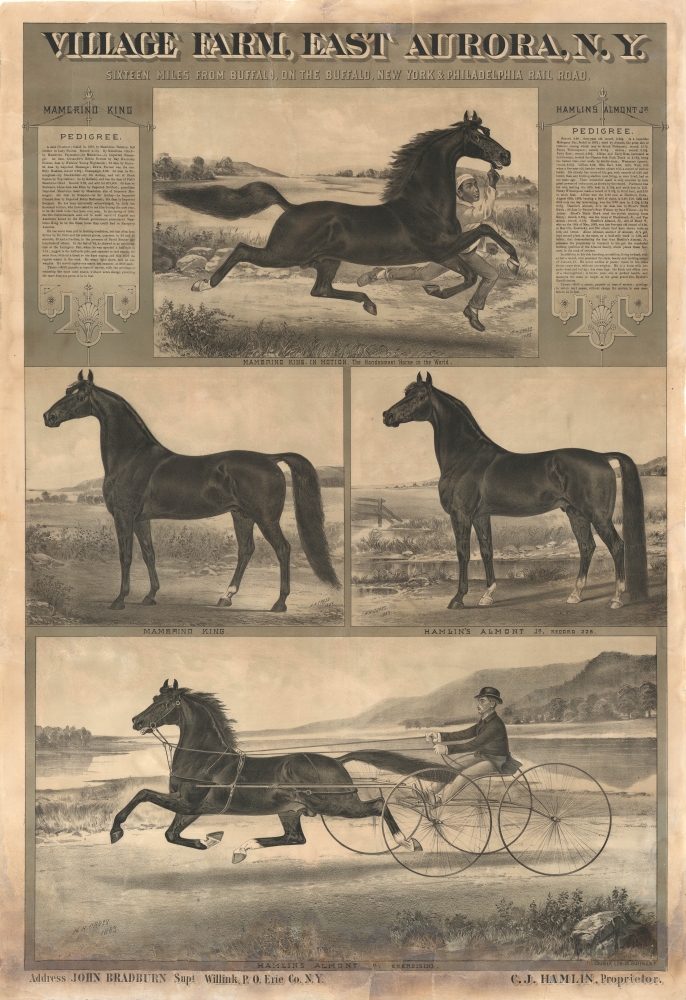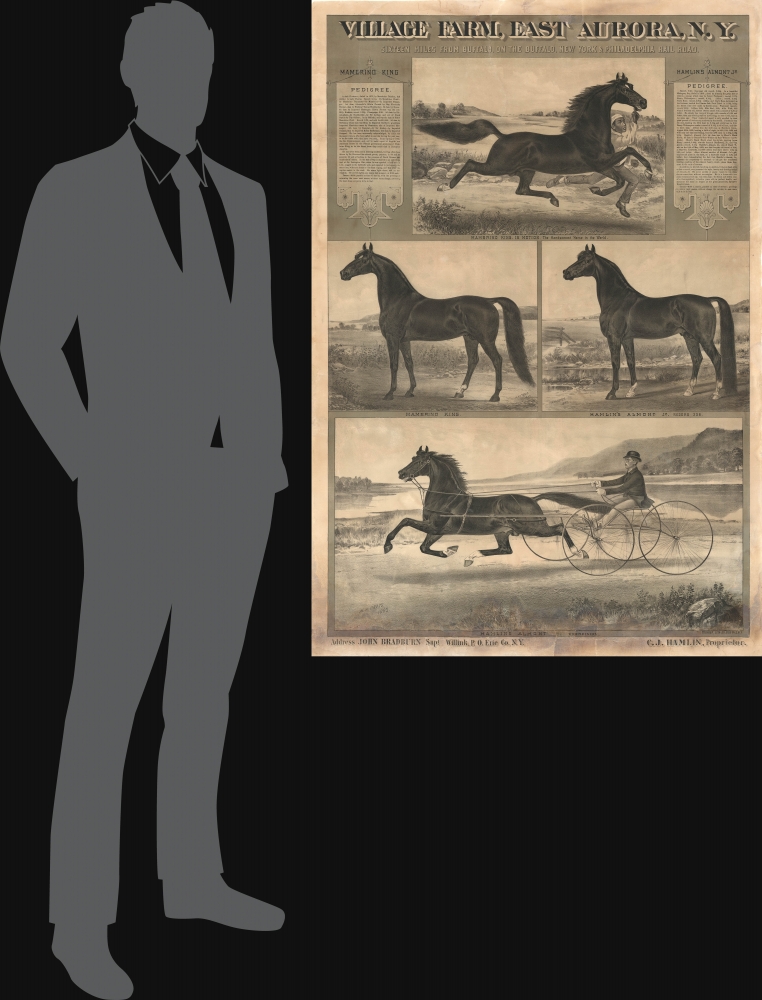1883 Broadside Advertisement for Village Farm Horses, East Aurora, NY
MambrinoKingVillageFarm-cross-1883
Title
1883 (dated) 43.5 x 30 in (110.49 x 76.2 cm)
Description
Village Farm, East Aurora
Village Farm (1865 - 1905) was one of the most successful horse breeding farms in the eastern United States during the late 19th century. It was founded in East Aurora, New York, in 1865 by Cicero Julius Hamlin (1819 - 1905), a prosperous businessman. The farm maintained a herd of about 800 racing horses, including the legendary Mambrino King. Village Farm produced such horse training legends as Pop Geers, W. J. Andrews, Alonzo McDonald and Ben White. Hamlin himself is considered one of the most influential harness-racing breeders of the 20th century.Mambrino King
The start stallion, Mambrino King (1872 - 1899), called 'the handsomest horse in the world' is presented at top center. Cicero J. Hamlin of Village Farm bought Mambrino King for a whopping 17,000 USD (about 500,000 USD today) as a premier stud in 1882. According to the 'East Aurora Advertiser' some 16,000 people visited the farm to gawk at the beautiful horse. According to Ken McCarr, writing in the the U.S. Trotting Association newsletter, Hoof Beats, 'one day the stallion was taken from his stall to be shown to the visitors on 170 different times … When shown on a lead shank by his groom, it was one of the sensational performances in that day and age'. Mambrino King himself was never trained for the track, but his line produced a number of significant horses, including the champion Nettie King, who in turn gave birth to world-record trotter The Abbot. Mambrino King is still a legend in East Aurora.Hamlins Almont Jr.
The other horse prominently presented is Hamlins Almont Jr. (1872 - 18??), another premier stallion, also of the Mambrino lineage. We find less press regarding Hamlins Almont Jr., but he is recorded in breading records as connected to many of the top trotters of his age. His offspring were known for both speed and endurance, setting many period records.Publication History and Census
This broadside lithograph was issued in 1883. It was illustrated by Henry Herman Cross and converted to lithographic stone for printing by The Courier Lithograph Company of Buffalo. We see no other surviving examples.CartographerS
Henry Herman Cross (November 23, 1837 - April 2, 1918) was an American painter best known for his wildlife and nature scenes, horse racing imagery, and American Indian portraits. He typically signed his work 'H.H. Cross'. Cross was born in Flemingville, New York. He was described by Buffalo Bill Cody as the 'greatest painter of Indian portraiture of all times.' (Samuels 116). According to stories, as a teen-ager he ran away several times to join a circus, and then at 16, traveled to Paris where is studied under animal painter Rosa Bonheur from 1853 to 1855. He had a portrait studio in Chicago in the early 1860s, before moving to Minnesota during the Sioux Wars - where he mastered the Sioux language. He was in California during 1864-65 to paint the horses of Lucky Baldwin. He died in Chicago. More by this mapmaker...
Courier Company (1860 – 1908), also known as the Courier Lithograph Company, was a printing firm based in Buffalo, New York. The Courier Company was organized in 1860 by the publishers of the Buffalo Courier, a local newspaper, but the printing concern dates to 1849. Many prominent figures in Buffalo were associated with the company, and under their guidance it soon grew into the largest poster publishing firm in the United States, if not the world. An individual named Tom Kean played an important role in the founding and early years of the company and used his decades of experience in working with actors and actresses to drive the firm's initial success. The Courier Company, however, truly began to expand because of the influence of Joseph 'Joe' Warren. Warren began working for the firm in 1854 as the local editor and then was elected Superintendent of Schools in 1857, further raising his local notoriety. Warren was also well known in Buffalo as a political organizer and was named the leader of the Democrats in Western New York following the death of Dean Richmond in 1866. When the Courier Company was organized in 1860, Warren was named its first president. Charles W. McCune, a remarkably successful businessman, was recruited to take over the company in 1873. McCune had worked since the age of fifteen for A.T. Stewart and Company, a large dry goods company in New York City, and by age of twenty worked as that firm's purchasing agent in Europe. McCune was also associated with two other companies before he formed his own partnership, McCune, Scott, and Cooper. He achieved such a level of success that, in 1873, three years after founding his own partnership, he was planning to settle down in Paris, but was called to take the reins of the Courier Company, where he was manager by 1874. McCune officially succeeded Warren as president of The Courier Company in 1880. By this time, Courier had moved beyond only printing, but was known for book printing, commercial and railroad printing, bookbinding, manufacture of blank books, wood engraving lithography, illustrated catalogues, and, of course, the Buffalo city directory. McCune died at the height of his career in the early 1880s, and was succeeded as president of the Courier Company by George Bleistein. Under Bleistien's leadership, Courier moved into the 20th century and adopted many innovative printing practices, including lithography, electrotyping, and metal engraving, Over the course of the firm's history, their clients included P.T. Barnum, for whom they were the exclusive printer in 1887, and the Ringling Brothers circus. Courier printed most of the Ringling Brother's posters from 1890 until 1906. Per the 1901 book, Buffalo – Old and New (which was published by Courier), their factory covered 130,000 square feet in downtown Buffalo, employed 300 people, and operated sixty-three printing presses. In the ultimate irony, the Courier Company, which had pioneered fireproof construction practices in Buffalo, met its end on Friday, February 14, 1908, when its offices were ravaged by a fire, destroying a $180,000 order for circus advertisements and many of their larger presses. Learn More...




